Description
Students will play a modified game of bingo to learn about individual cetacean species.
Objectives
By the conclusion of these activities, students will:
- Be able to recognize some common cetacean species
- Be able to list a characteristic (biology or natural history) of at least one of these animals
What You Will Need
- Copies of cetacean fact sheets (one copy of each fact sheet)
- Bingo cards (pages 3-3 to 3-32; one per student) and bingo markers (you could use small foam pieces or paper cutouts—anything that the students can use to cover the squares on their bingo sheets. If bingo sheets are laminated, dry erase or washable markers could be used. A sheet of "bingo chips" is provided on page 3-33; this can be copied and given to students to cut out and use to cover the squares on their bingo cards)
- Bingo call sheet (pages 3-34 to 3-35 and/or pages 3-36 to 3-37)
- Optional: PowerPoint bingo presentation (there are two versions, corresponding to call sheets 1 and 2) and ability to project this (these can be downloaded from https://www.flseagrant.org/cetaceans/)
Standards
Common Core Standards
ELA/Literacy
- RI.4.1 Refer to details and examples in a text when explaining what the text says explicitly and when drawing inferences from the text.
Strategy
- Give each student one of the cetacean fact sheets. If there are fewer than 16 students or groups, some students/groups should receive two fact sheets so all fact sheets are distributed. If there are more than 16 students, you can either group the students or make additional copies of fact sheets.
- Give each student one of the bingo cards (and one of the bingo chip sheets on page 3-33, if needed). If bingo chip sheets are used, give students time to cut out the squares before starting the game.
- Explain that the class will be playing a game of bingo, but with a twist. Instead of the caller (the teacher) simply calling out the name of a whale or dolphin, sometimes they will be calling out a clue. The students will need to read their fact sheets to see if the clue matches the whale or dolphin on their fact sheet. If it does, they need to raise their hand and tell the class the name of their whale or dolphin. At that time, students who have that animal on their bingo cards can cover it.
- The bingo cards have some cetaceans listed for which there are no fact sheets. The teacher will simply call the name of those animals, rather than a clue.
- Explain that the first objective is to get five whales lined up in a row. Once someone has five in a row (horizontally, vertically, or diagonally), they should call out, "Bingo." You will then continue the game until someone has their entire card covered (all 16 spaces.) Alternately, you can play until each person has achieved a bingo.
- There is a printed and a PowerPoint version of the bingo call sheet(s). It may be best to use the provided PowerPoint presentation(s) to allow the students to see the information that is being read as well as a picture of the cetacean. Use the clues until someone calls out, "Bingo." Once someone calls, "Bingo," check the whales that they have covered. Remind everyone not to clear their cards yet, and continue with the clues until someone has achieved the next bingo.
- Note that there are 30 unique bingo cards for this activity and two unique "call lists" in case the class wishes to repeat the game (or if the teacher wants to offer to repeat it as a reward for the class later in the school year)!
Cetacean Bingo
Bingo Cards

Call List for Cetacean Bingo Game
List 1
- This whale has one of the longest known migrations of any mammal, traveling about 10,000 miles. [Answer: Gray whale]
- Dwarf sperm whale
- This whale comes to warm Florida waters to have its babies (calves) every winter. It can sometimes be seen from the beaches of northeast Florida. [Answer: North Atlantic right whale]
- This small mysticete only grows to about 30 feet long and is found in all oceans. It is not currently endangered but is protected in US waters by the Marine Mammal Protection Act. [Answer: Minke (MIN-key) whale]
- Individual whales of this species can be identified by the white markings on their flippers and on the underside of their tail flukes. [Answer: Humpback whale]
- Northern bottlenose whale
- Harbor porpoise
- Vaquita (vah-KEY-tah)
- Northern right whale dolphin
- This unusual odontocete hunts squid and octopus. It has grooves in its throat to help suck in prey. [Answer: Cuvier's (COO-vee-yays) beaked whale]
- Until about 1965, whalers killed up to 30,000 of these endangered mysticetes each year. These whales are now protected, but there is a small amount of tribal hunting in Greenland. [Answer: Fin whale]
- These small odontocetes have long, slender snouts and are easily recognized because they jump out of the water and spin their bodies around several times before re-entering the water. [Answer: Spinner dolphin]
- Atlantic spotted dolphin
- This whale is the biggest animal that has ever lived. It is larger than the largest dinosaur. [Answer: Blue whale]
- This whale is born dark gray but becomes snowy white as it matures, so it is often called "the white whale." [Answer: Beluga (buh-LOO-guh) whale]
- This whale has a bracket-shaped marking behind its eye, which looks like the gill of a fish. [Answer: Pygmy sperm whale]
- This dolphin is commonly seen throughout the coastal waters of Florida. It is important to remember that feeding this dolphin can be harmful to the animal and is illegal. [Answer: Bottlenose dolphin]
- Bowhead whale
- Pacific white-sided dolphin
- This rare dolphin species may be extinct. A live animal has not been seen since 2002. [Answer: Chinese river dolphin]
- Risso's (RIH-z-ohs) dolphin
- Males of this species grow a single elongated tusk that may be many feet long. This structure is thought to be the basis of the mythical unicorn horn. [Answer: Narwhal (NAR-wull)]
- This large odontocete is easily recognizable due to its large, bulbous melon head. Its body is black or dark brown, and it has a large gray "saddle" behind the dorsal fin. [Answer: Short-finned pilot whale]
- This whale is the largest of the odontocetes. [Answer: Sperm whale]
- Common dolphin
- Bryde's (BROO-duss) whale
- This whale was given its name because it has been known to kill other whales and even great white sharks. [Answer: Orca/killer whale]
- Rough-toothed dolphin
- False killer whale
- Sei (SAY or SIGH) whale
List 2
- These dolphins are commonly found in zoos and aquaria. One female has lived in an aquarium at Marineland, Florida for more than 58 years. [Answer: Bottlenose dolphin]
- Northern right whale dolphin
- Sei (SAY or SIGH) whale
- These whales can be recognized by the big white growths (callosities) on their heads. Unique patterns of callosities are used to identify individual animals. [Answer: North Atlantic right whale]
- Atlantic spotted dolphin
- Males of this whale species have two small teeth that stick out of the lower jaw, which they use for fighting. [Answer: Cuvier's (COO-vee-yays) beaked whale]
- This whale is famous for its songs. Males repeatedly sing 10- to 20-minute songs for hours on end. Individual whales can be identified by their unique songs. [Answer: Humpback whale]
- Bryde's (BROO-duss) whale
- Calves of this whale species can gain weight at a rate of 10 pounds per hour. [Answer: Blue whale]
- Rough-toothed dolphin
- This whale's tongue is half yellow or white and half mottled black. [Answer: Fin whale]
- These mysticetes are fast swimmers; they can swim up to 21 miles per hour. [Answer: Minke (MIN-key) whale]
- Northern bottlenose whale
- Common dolphin
- These whales have white barnacles on their heads, and may also have orange crab-like animals called cyamids on their bodies. [Answer: Gray whale]
- Risso's (RIH-z-ohs) dolphin
- Vaquita (vah-KEY-tah)
- This whale is the same type as the famous Moby Dick. Adult males have been documented occasionally striking boats for unknown reasons, causing very severe damage. [Answer: Sperm whale]
- False killer whale
- Pacific white-sided dolphin
- Historically, this dolphin inhabited the Yangtze River in China. Sadly, it is now believed to be extinct. [Answer: Chinese river dolphin]
- This whale is severely threatened by climate change. As more Arctic ice melts, ship traffic in its home range increases. This whale is at a greater risk of being hit by ships. [Answer: Narwhal (NAR-wull)]
- Harbor porpoise
- Bowhead whale
- This small-toothed whale usually travels in large groups of 20 to 90 animals. These whales are involved in "mass stranding" events along the Florida coastline every few years. Some of these stranding events may involve more than 100 animals coming onshore at the same time. [Answer: Short-finned pilot whale]
- A few of these whales are kept in captivity. Some of these have lived in Florida for more than 40 years. [Orca/killer whale; Bottlenose dolphin could be another correct answer, but you have already called a clue for bottlenose dolphins.]
- Dwarf sperm whale
- This is the only whale that has a flexible neck and the ability to move its head up and down, and side to side. Scientists believe this ability helps it to hunt for prey on the bottom in shallow areas. [Answer: Beluga (buh-LOO-guh) whale]
- When startled or frightened, this whale can release large amounts of reddish-brown liquid, or "ink," to confuse predators. [Answer: Pygmy sperm whale]
- These dolphins travel in very large groups, sometimes up to several thousand animals. They can be seen jumping out of the water and spinning over and over again. [Answer: Spinner dolphin]
Image Sources
Pacific white-sided dolphin: http://www.nmfs.noaa.gov/pr/images/cetaceans/pacificwhitesideddolphins_swfsc.jpg
Credits: NOAA Fisheries
Northern right whale dolphin: https://www.fisheries.noaa.gov/species/northern-right-whale-dolphin
Credits: NOAA Fisheries
Bowhead whale: http://www.nmfs.noaa.gov/pr/pdfs/education/kids_times_whale_bowhead.pdf
Credits: NOAA Fisheries
Vaquita: https://www.flickr.com/photos/nmfs_northwest/21824239225
Credits: Uko Gorter
Beluga whale: https://en.wikipedia.org/wiki/File:Beluga03.jpg
Credits: Greg Hume
Narwhal: https://www.fisheries.noaa.gov/species/narwhal
Credits: Kristin Laidre (NOAA)
Gray whale: http://www.nmfs.noaa.gov/pr/images/cetaceans/graywhale_afsc-merrillgosho.jpg
Credits: NOAA Fisheries
Cetacean Fact Sheets
These fact sheets were developed for use with lessons in the Cetaceans 4 Grade Curriculum, using the most current data available at the time (2013). However, as research continues on these animals, the data in these fact sheets may become outdated. Teachers should check the NOAA Fisheries Office of Protected Resources website (https://www.fisheries.noaa.gov/about/office-protected-resources) for the most current information. Additional information was obtained from fact sheets on the American Cetacean Society website (https://www.acsonline.org/fact-sheets) and the following scientific journal articles:
Garde, E., M. P. Heide-Jørgensen, S. H. Hansen, G. Nachman, and M. C. Forchhammer. 2007. "Age-specific growth and remarkable longevity in narwhals (Monodon monoceros) from West Greenland as estimated by aspartic acid racemization." Journal of Mammalogy 88(1): 49–58. https://doi.org/10.1644/06-MAMM-A-056R.1
Ponganis, P. J. 2011. "Diving mammals." Comprehensive Physiology 1: 517–535. doi: 10.1002/cphy.c091003
Stewart, R. E. A., S. E. Campana, C. M. Jones, and B. E. Stewart. 2006. "Bomb radiocarbon dating calibrates beluga (Delphinapterus leucas) age estimates." Canadian Journal of Zoology 84: 1840–1852.
*Beluga age estimates are obtained by counting growth lines in their teeth. Research published in 2006 by Stewart et al. showed that previous estimates of two growth lines per year were incorrect, and belugas actually have one growth line per year. Many sources quote the lifespan of belugas as 30 to 50 years, but those estimates are based on the assumption of two growth lines per year. The 2006 paper estimates a lifespan of 77 to 79 years for belugas.
Photo/Image Sources
Whale illustrations by Garth Mix were provided by NOAA Fisheries. Thanks to Jonathan Shannon (NOAA Fisheries) for providing several photographs for these fact sheets.
Beluga: https://en.wikipedia.org/wiki/File:Beluga03.jpg
https://upload.wikimedia.org/wikipedia/commons/4/4b/Beluga_size.svg
http://www.nmfs.noaa.gov/pr/pdfs/rangemaps/belugawhale.pdf
Blue whale: https://upload.wikimedia.org/wikipedia/commons/d/d3/Blue_Whale_001_noaa_body_color.jpg
http://www.nmfs.noaa.gov/pr/pdfs/rangemaps/bluewhale.pdf
Humpback whale:
http://www.nmfs.noaa.gov/pr/images/cetaceans/humpbackwhale_noaa_large.jpg
http://www.nmfs.noaa.gov/pr/pdfs/rangemaps/humpbackwhale.pdf
Killer whale: http://www.nmfs.noaa.gov/pr/species/mammals/cetaceans/killerwhale_photos.htm
http://www.nmfs.noaa.gov/pr/pdfs/rangemaps/killerwhale.pdf
North Atlantic right whale: http://www.nmfs.noaa.gov/pr/images/cetaceans/narw_flfwc-noaa.jpg
http://www.nmfs.noaa.gov/pr/pdfs/rangemaps/northatlanticrightwhale.pdf
Bottlenose dolphin: www.nmfs.noaa.gov/pr/pdfs/rangemaps/bottlenosedolphin.pdf
Sperm whale: www.nmfs.noaa.gov/pr/pdfs/rangemaps/spermwhale.pdf
Narwhal: http://www.noaanews.noaa.gov/stories2010/images/narwhal_pod_hires.jpg
https://upload.wikimedia.org/wikipedia/commons/a/ac/Narwhal_size.svg
https://en.wikipedia.org/wiki/File:Cetacea_range_map_Narwhal.png
Pygmy sperm whale: http://swfsc.noaa.gov/textblock.aspx?ParentMenuId=230&id=1428
www.nmfs.noaa.gov/pr/pdfs/rangemaps/pygmyspermwhale.pdf
Cuvier's beaked whale: https://upload.wikimedia.org/wikipedia/commons/3/3d/Cuvier%27s_beaked_whale_size.svg
http://www.nmfs.noaa.gov/pr/pdfs/rangemaps/cuviersbeakedwhale.pdf
Minke whale: http://www.birds.cornell.edu/brp/images2/MinkeWhale_NOAA.jpg/view
www.nmfs.noaa.gov/pr/pdfs/rangemaps/minkewhale.pdf
Fin whale: www.nmfs.noaa.gov/pr/pdfs/rangemaps/finwhale.pdf
Chinese river dolphin: https://upload.wikimedia.org/wikipedia/commons/5/5e/Lipotes_vexillifer.png
https://upload.wikimedia.org/wikipedia/commons/a/a4/Baiji_size.svg
www.nmfs.noaa.gov/pr/pdfs/rangemaps/chineseriverdolphin.pdf
Short-finned pilot whale: https://www.fisheries.noaa.gov/science-blog/hiceas-hilite-diving-secret-lives-short-finned-pilot-whales
Spinner dolphin: www.nmfs.noaa.gov/pr/pdfs/rangemaps/spinnerdolphin.pdf
Gray whale: https://upload.wikimedia.org/wikipedia/commons/b/b8/Gray_whale_size.svg
http://www.nmfs.noaa.gov/pr/pdfs/rangemaps/graywhale.pdf
Beluga Whale (Pronounced: buh-LOO-guh)
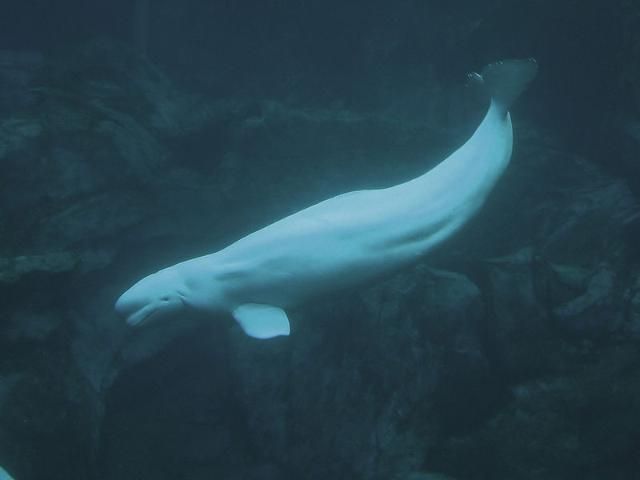
Credit: Greg Hume
Common Name: Beluga whale
Scientific Name: Delphinapterus leucas
Type of Whale: Toothed (odontocete)
Maximum Length: 16 feet (5 meters)
Maximum Weight: 3,300 pounds (1,500 kilograms)
How long can they live? Up to 79 years*
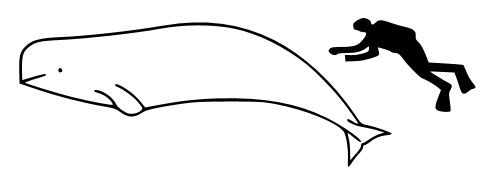
Credit: Chris_huh
Where do they live? Belugas live in the cold, polar arctic and subarctic areas near Alaska, Canada, and Russia. They can be seen swimming near icebergs when water temperatures are near freezing. Beluga whales can move from the ocean into rivers. Most marine cetaceans cannot survive for very long in fresh water. Belugas prefer very shallow coastal waters to the open ocean.
Special Characteristics: Belugas are also called white whales. Calves are dark gray when born. The gray color fades over time; the whales become snow white when mature. Belugas do not have a dorsal (back) fin.
What type of prey do they eat? Many types of fish, but they also eat shellfish (clams and mussels), shrimp, squid, octopus, and even crabs.
What type of predator might eat them? Killer whales and polar bears both will eat belugas. Belugas can be trapped by ice, making it easier for a polar bear to get them. Belugas that are trapped by ice can also suffocate.
What are the human threats? Humans have hunted beluga whales for their thick skin, which has been used for leather. Shipping, oil and gas production and transport, commercial fishing gear, pollution, habitat destruction, and noise are all threats to belugas.
Are they endangered? Although global estimates of beluga whales exceed 60,000 animals, there is one subpopulation that is considered highly endangered. The belugas of Cook Inlet have had their population reduced, and only about 280 animals are believed to remain there. All cetaceans are protected under the Marine Mammal Protection Act.
Fun Facts: Belugas are the only cetaceans that can move their necks. The neck vertebrae of most whales are fused (joined together), but this is not the case for belugas. Scientists think the belugas' ability to move their necks may help them hunt for prey in very shallow water. Belugas are also called "canaries of the sea" because of the sounds they make. Unlike other whales and dolphins, belugas' melons move visibly when they are singing. As much as 40% of a beluga whale's weight is blubber!
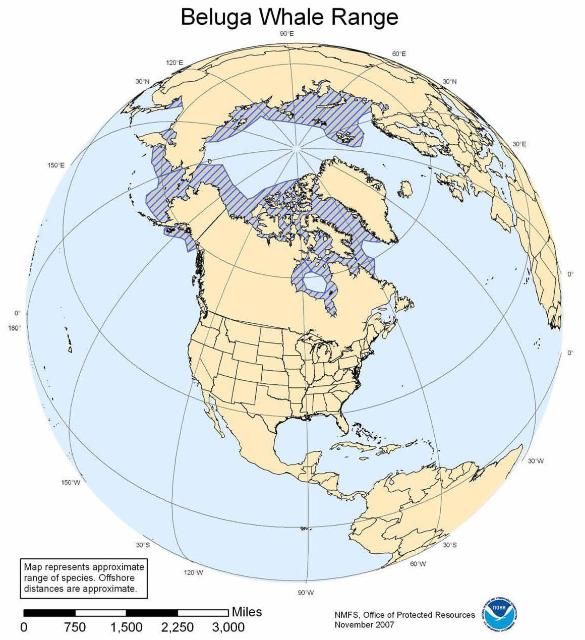
Credit: NOAA Fisheries Office of Protected Resources
Blue Whale
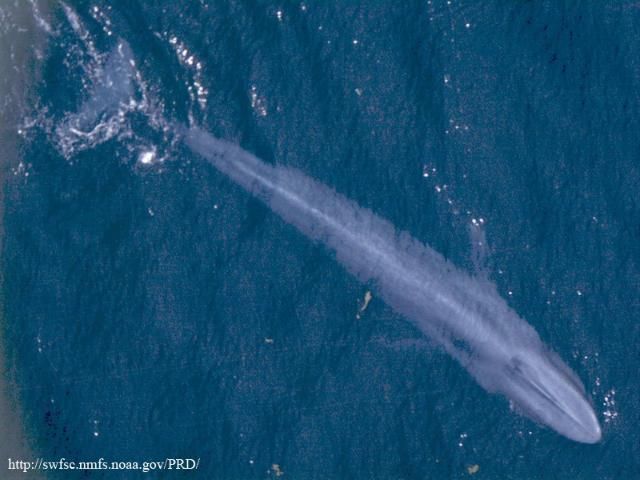
Credit: NOAA Fisheries
Common Name: Blue whale
Scientific Name: Balaenoptera musculus
Type of Whale: Baleen (mysticete)
Maximum Length: A blue whale 108 feet (33 meters) long was reported in waters near Antarctica. Whales in the North Atlantic and North Pacific Oceans reach about 88 feet (27 meters) in length.
Maximum Weight: 330,000 pounds (150,000 kilograms)

Credit: Garth Mix and Chris_huh
How long can they live? At least 40 years, but possibly up to 90 years.
Where do they live? Blue whales can be found anywhere in the ocean; however, most sightings occur in colder waters.
Special Characteristics: Blue whales have long, slender bodies. They are mottled gray, but they appear blue when seen through the water. Their heads look wide and flat when viewed from above.
What type of prey do they eat? Krill (shrimp-like animals that are about the size of a jelly bean).
What type of predator might eat them? Killer whales have been documented attacking a blue whale off the coast of Baja California. Many blue whales in the Pacific seem to have scars that suggest attacks by killer whales. In the North Atlantic, blue whales have also been hurt or killed after accidentally getting trapped in ice.
What are the human threats? Ship strikes and entanglement in commercial fishing gear are the main threats to blue whales. Noise and disturbance by whale watching boats are also possible threats.
Are they endangered? Yes. Blue whales are considered endangered throughout their range. Population estimates range from about 4,000 to 6,000 animals worldwide.
Fun Facts: Blue whale calves may grow 2 inches (5 centimeters) a day and gain 10 pounds (4.5 kilograms) in an hour. Blue whales are the largest animals to ever live, bigger than even the biggest dinosaur. Blue whales can hold their breath for up to 50 minutes and can dive to depths of 330 feet (100 meters).
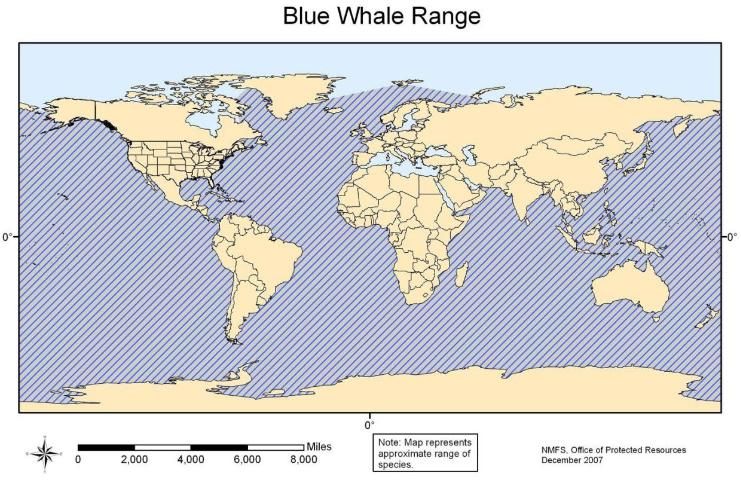
Credit: NOAA Fisheries Office of Protected Resources
Humpback Whale
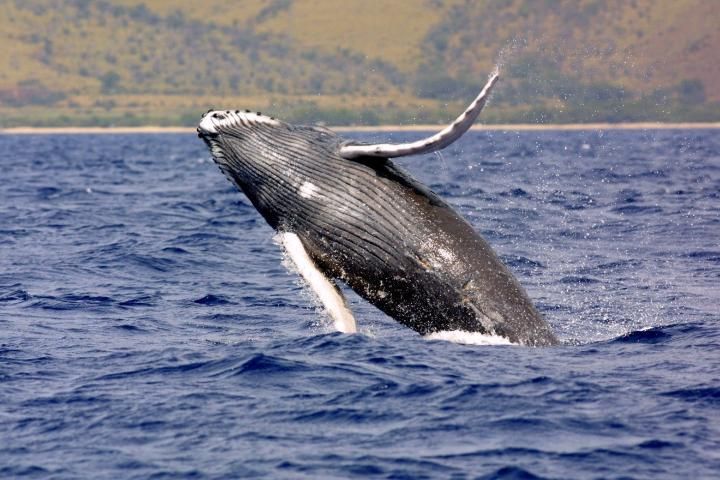
Credit: NOAA
Common Name: Humpback whale
Scientific Name: Megaptera novaeangliae
Type of Whale: Baleen (mysticete)
Maximum Length: 48 feet (14.6 meters)
Maximum Weight: 80,000 pounds (36,287 kilograms)
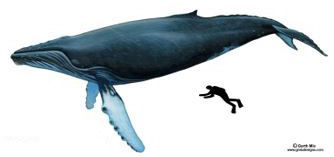
Credit: Garth Mix and Chris_huh
How long can they live? Scientists estimate humpbacks can live 40 to 50 years.
Where do they live? Humpback whales can be found in every ocean. Most humpback populations migrate to cold temperate waters during the summer to feed and move to warm tropical waters in the winter for breeding and calving.
Special Characteristics: Humpback whales can be easily recognized by their very large white flippers.
What type of prey do they eat? Krill (small, shrimp-like animals) and very small fish.
What type of predator might eat them? Orcas (killer whales)
What are the human threats? Historically, humans were the humpback's most significant predator. Whalers hunted them heavily until the whales were protected in the 1960s and 1970s. Today, main threats include entanglement in fishing gear, ship strikes, and harassment by whale watching boats. Some nations are also proposing to start hunting them again.
Are they endangered? Yes, humpbacks are considered endangered throughout their range.
Fun Facts: Humpback whales are famous for their unique singing behavior. Adult male humpback whales sing songs that last an average of 10 to 20 minutes. They will repeat the same song over and over for many hours. Different populations of whales can be identified by their unique songs. The purpose of the singing behavior is not understood, but some scientists think it may have to do with mating behavior. Individual humpback whales can be identified by the pattern of white markings on the underside of the tail fluke. Humpback whales can hold their breath for up to 20 minutes and can dive to depths of up to 500 feet (150 meters).
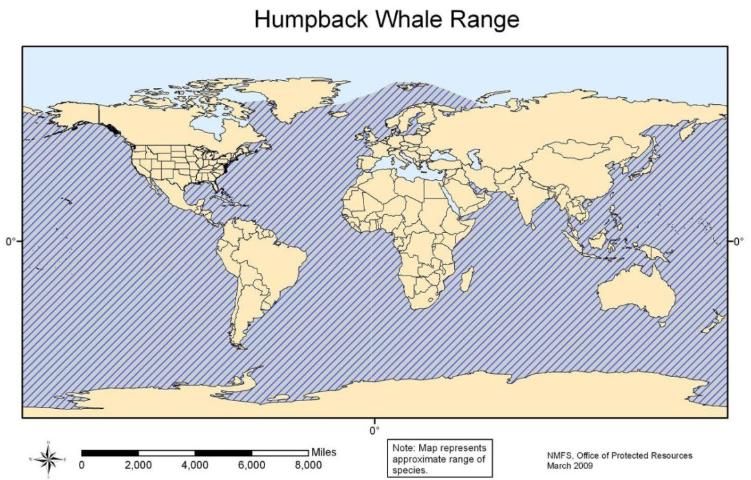
Credit: OAA Fisheries Office of Protected Resources
Orca/Killer Whale
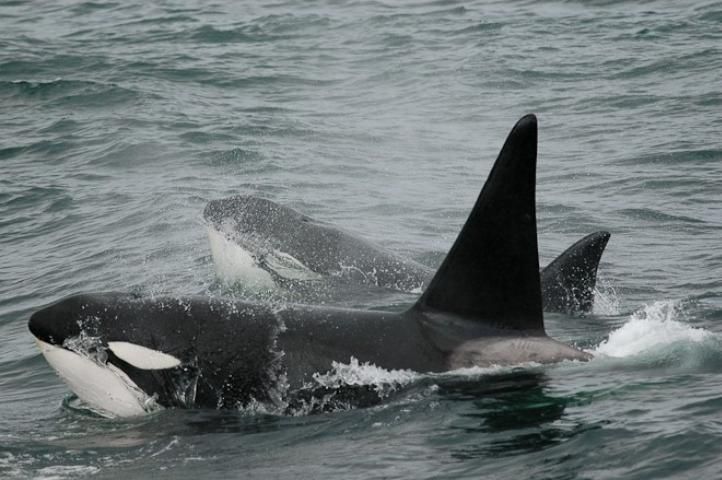
Credit: NOAA AFSC
Common Name: Orca or Killer whale
Scientific Name: Orcinus orca
Type of Whale: Toothed (odontocete)
Maximum Length: 30 feet (9 meters)
Maximum Weight: 12,000 pounds (5,600 kilograms)
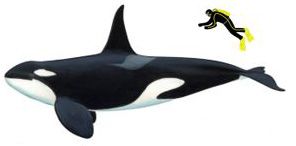
Credit: Garth Mix and Chris_huh
How long can they live? Males: up to 60 years. Females: up to 90 years.
Where do they live? Killer whales are found in every ocean, but they prefer colder waters. They are usually found in northern temperate waters within 500 miles (800 kilometers) of shore.
Special Characteristics: Killer whales have distinctive black and white coloration. They have grey or white patches behind their dorsal fins. These patches are called saddles.
What type of prey do they eat? Fish (they love salmon) or other marine mammals, including seals and very large whales.
What type of predator might eat them? In rare instances, great white sharks may be able to take a killer whale. However, wildlife filmmakers have recently shown killer whales attacking and killing a large great white shark.
What are the human threats? Main threats include contaminants in the water (e.g., pesticides), human overfishing of the whales' prey items, ship collisions, and oil spills. Other threats may include noise, entanglement in fishing gear, and harassment by whale watching boats.
Are they endangered? One small population of killer whales living near Puget Sound, Washington, is considered endangered. All other killer whales, like all cetaceans, are protected under the Marine Mammal Protection Act.
Fun Facts: There are three kinds, or ecotypes, of killer whales: Resident, Transient, and Offshore. The Resident killer whales tend to live in coastal waters and eat fish. These whales love to eat salmon when the fish return to the rivers to spawn. The Transient whales hunt in the open sea and eat other marine mammals. These are the only whales that are capable of hunting in packs, and for this reason, they have been called "the wolves of the sea." By hunting as a team, they are able to kill and eat much larger whales. The Offshore killer whales are not well understood, but scientists think that these whales are also fish eaters. Killer whales can hold their breath for up to 15 minutes and can dive to depths of 825 feet (250 meters).
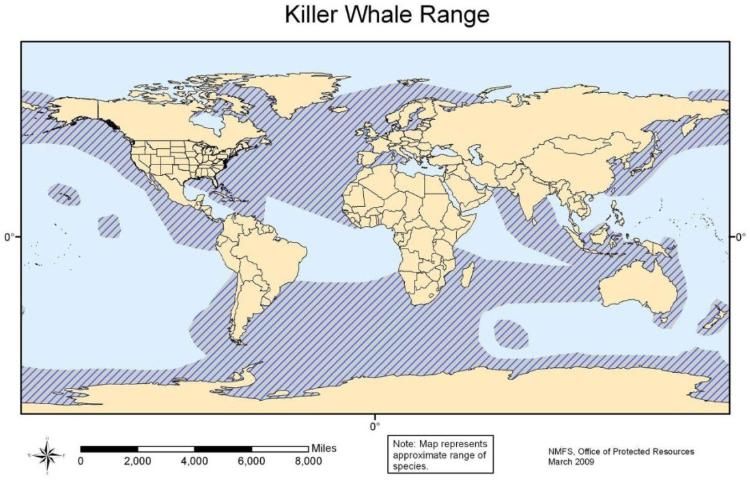
Credit: NOAA Fisheries Office of Protected Resources
North Atlantic Right Whale
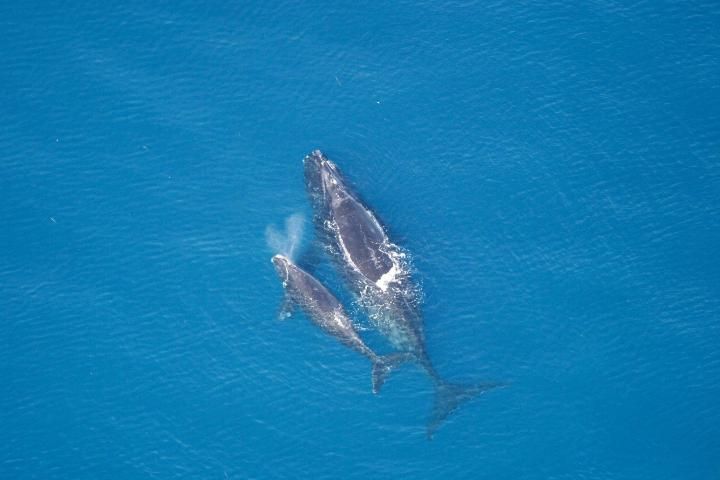
Credit: NOAA
Common Name: North Atlantic right whale
Scientific Name: Eubalaena glacialis
Type of Whale: Baleen (mysticete)
Maximum Length: 55 feet (16.7 meters)
Maximum Weight: 140,000 pounds (63,500 kilograms)
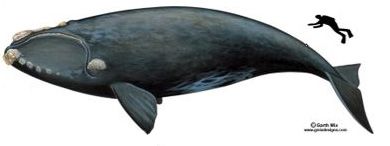
Credit: Garth Mix and Chris_huh
How long can they live? We have very little data on the lifespan of these whales, but scientists estimate they may live up to 50 years.
Where do they live? The North Atlantic right whale lives along the Atlantic coast of North America. Females and young animals swim to waters off the coasts of Georgia and Florida during the winter. However, it is not clear where the adult males go in the winter. Right whales travel to the Bay of Fundy to feed during the summer months.
Special Characteristics: Right whales develop big white growths called callosities on their heads. The pattern of callosities is unique to each animal, and these patterns are used to recognize specific individuals. A catalog of these animals is maintained. Almost every North Atlantic right whale is recognizable as an individual.
What type of prey do they eat? Zooplankton (very tiny animals that live in the planktonic soup. Many types of zooplankton are larval fish or very tiny, shrimp-like animals).
What type of predator might eat them? Sharks will feed on carcasses of North Atlantic right whales. It seems doubtful that they could eat a healthy adult. However, calves may be at risk, especially if they are sick or injured.
What are the human threats? Ship collisions and entanglement in fishing gear are the major threats to North Atlantic right whales. Noise may also affect these whales.
Are they endangered? Yes. These whales are critically endangered. There may be as few as 340 left.
Fun Facts: Right whales are called "right whales" because they were the "right" whale to hunt. They move slowly and are often found close to shore. When killed, the carcass would float rather than sink, making it much easier to harvest from small boats.
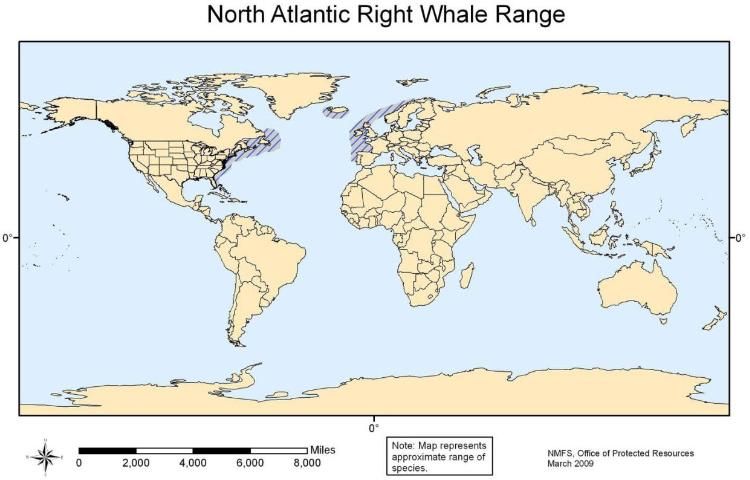
Bottlenose Dolphin
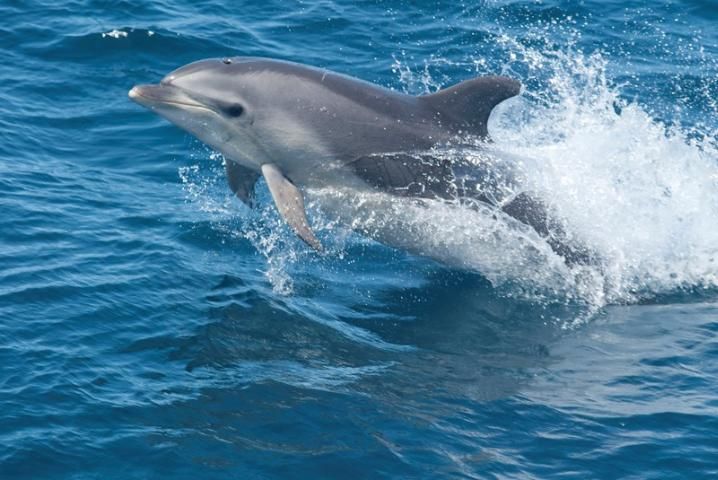
Credit: Allison Henry, NOAA/NEFSC
Common Name: Bottlenose dolphin
Scientific Name: Tursiops truncatus
Type of Whale: Toothed (odontocete)
Maximum Length: Up to about 9 feet (2.8 meters) in Florida coastal waters
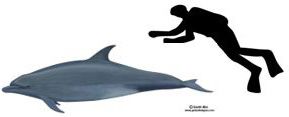
Credit: Garth Mix and Chris_huh
Maximum Weight: In Florida, the maximum weight is about 600 pounds (about 280 kilograms). Offshore bottlenose dolphins may be much larger and heavier.
How long can they live? The oldest documented wild bottlenose dolphin is 67 years old (as of 2017); it is in Sarasota Bay, Florida. The oldest bottlenose dolphin in captivity lived to be 61 years old at Marineland Dolphin Adventure in Florida.
Where do they live? Bottlenose dolphins are found worldwide in tropical and temperate waters. There are coastal and offshore populations.
Special Characteristics: Bottlenose dolphins always appear to be smiling because of their anatomy. They have no control over this expression.
What type of prey do they eat? Fish
What type of predator might eat them? Sharks
What are the human threats? Accidental injury and death because of entanglement in recreational and commercial fishing gear, exposure to pollutants and toxins, and direct harvest (in Japan and Taiwan).
Are they endangered? No. However, all cetaceans are protected under the Marine Mammal Protection Act.
Fun Facts: These are the dolphins most commonly seen performing at zoos and aquariums. Many parks allow visitors to swim with bottlenose dolphins. They have also been the stars of many TV shows and movies, including Flipper and Dolphin Tale. Baby dolphins have a few hairs on their rostrum that they lose shortly after birth. Bottlenose dolphins can hold their breath for up to 8 minutes and can dive to depths of 1,250 feet (390 meters). Bottlenose dolphins use a feeding strategy called "fish whacking" where they strike a fish with their tail flukes and knock it out of the water before eating it.
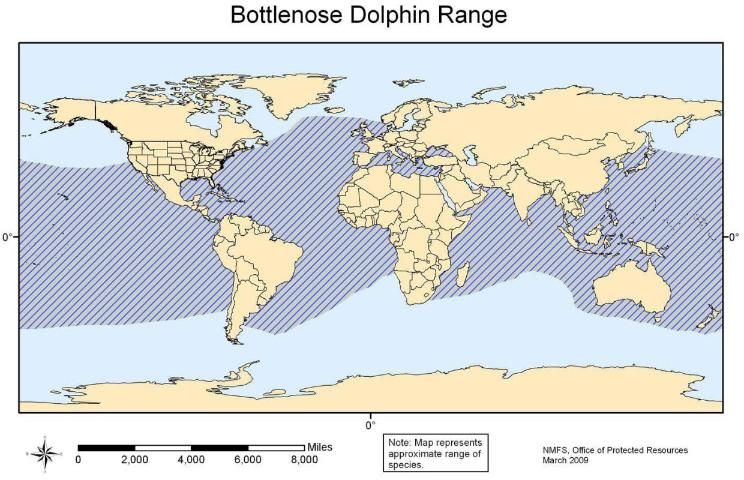
Credit: NOAA Fisheries Office of Protected Resources
Acknowledgment
The authors thank Dr. Randy Wells, Sarasota Dolphin Project, for review and comment.
Sperm Whale
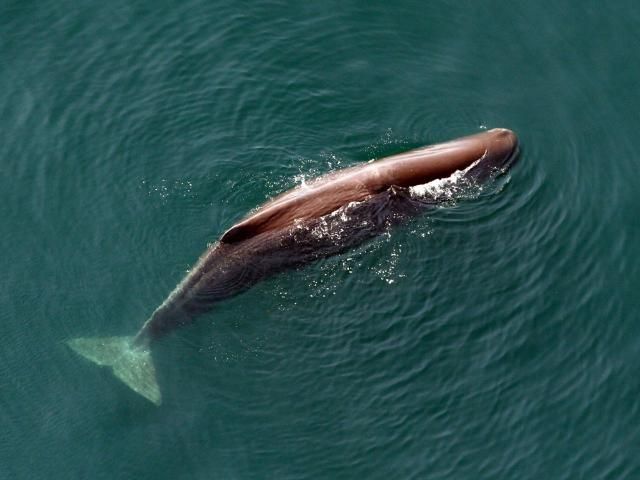
Credit: Christin Khan, NOAA/NEFSC
Common Name: Sperm whale
Scientific Name: Physeter macrocephalus
Type of Whale: Toothed (odontocete)
Maximum Length: Male sperm whales can grow to 52 feet (16 meters), making them the largest toothed whale. Females, while also very large, are smaller with a maximum length of about 36 feet (11 meters).

Credit: Garth Mix and Chris_huh
Maximum Weight: A large male sperm whale can weigh 90,000 pounds (40,823 kilograms). A large female is much smaller, weighing in at only 30,000 pounds (13,607 kilograms).
How long can they live? Up to 70 years.
Where do they live? Sperm whales can be found in all oceanic waters. They are deep water animals and are rarely found close to shore or in water less than about 984 feet (300 meters) deep. They are occasionally found in deep waters around some oceanic islands, including Hawai'i. Females and young whales tend to stay in warmer tropical and subtropical waters, but adult males may be found near pack ice in both the Northern and Southern Hemispheres.
Special Characteristics: Sperm whales have a single blowhole located on the left side of their heads rather than in the center. Their blow is easily recognized as left of center.
What type of prey do they eat? Giant squid, sharks, skates, and fish.
What type of predator might eat them? Adult sperm whales are probably not preyed on by other animals. Young or sick animals may be at risk of attack by sharks. There is a documented case of a sperm whale being hunted and killed by killer whales off the coast of California.
What are the human threats? Humans hunt sperm whales in some parts of the world. Ship strikes and entanglement in fishing gear are possible threats. Noise may also affect sperm whales.
Are they endangered? Yes, sperm whales are still considered endangered, but the species seems to be recovering.
Fun Facts: The famous book Moby Dick was about a white sperm whale. Adult male sperm whales occasionally attack ships for unknown reasons and can cause catastrophic damage. The sperm whale is an extremely deep-diving whale, diving down more than 7,400 feet (2,250 meters). These whales can hold their breath for up to two hours!
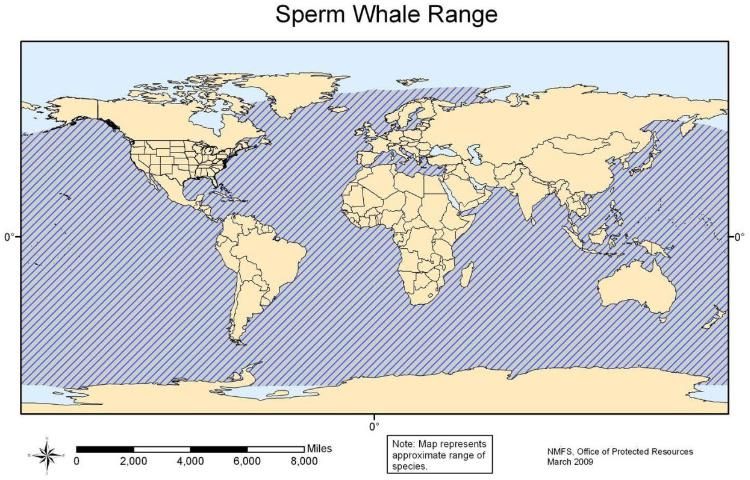
Credit: NOAA Fisheries Office of Protected Resources
Narwhal (Pronounced: NAR-wull)
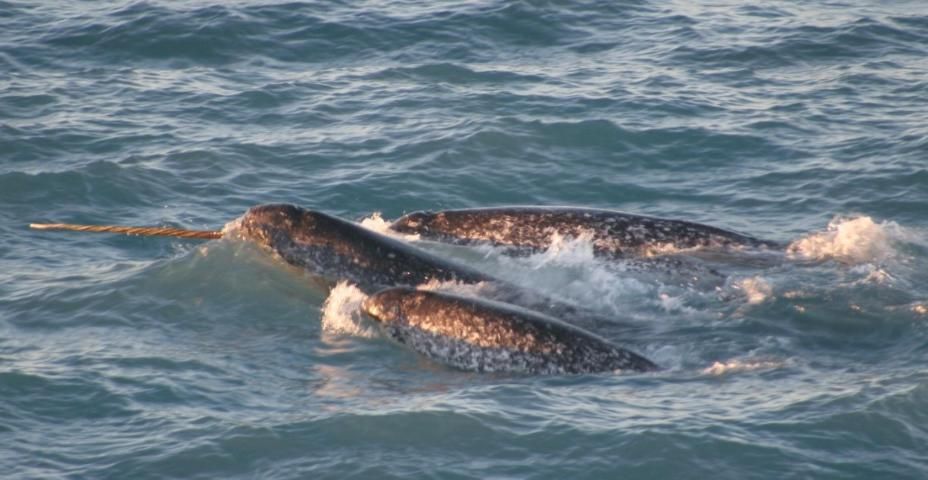
Credit: Kristin Laidre/NOAA
Common Name: Narwhal
Scientific Name:
Type of Whale: Toothed (odontocete)
Maximum Length: Males: 15 feet (4.6 meters); Females: 13 feet (4 meters)
Maximum Weight: Males: 3,500 pounds (1,600 kilograms); Females: 2,000 pounds (900 kilograms)

Credit: Chris_huh
How long can they live? 115 years
Where do they live? Arctic Ocean
Special Characteristics: Male narwhals have an elongated tusk, which is actually a tooth that grows through the front of the jaw. Adult narwhals typically have a spotted pattern. Narwhals have no dorsal fin, which may make it easier for them to swim underneath ice.
What type of prey do they eat? Arctic cod (fish), flatfish, squid, and oceanic shrimp.
What type of predator might eat them? Orcas (killer whales), walruses, and polar bears.
What are the human threats? Climate change is the main threat to narwhals. Most scientists agree that human activity is accelerating climate change. As ice in the Arctic melts, more ships enter Arctic waters. This increases the narwhals' risk of being hit by ships. Exploration for oil drilling is another threat to narwhals.
Are they endangered? No. However, all cetaceans are protected under the Marine Mammal Protection Act.
Fun Facts: The narwhal's long, spiral tusk may be the inspiration for the myth of the unicorn. Narwhals have a thick layer of blubber. They migrate offshore in the fall, perhaps so they will not be trapped by near-shore ice in the winter. Male narwhals probably use their tusks to fight other males over a female whale. The narwhal can hold its breath for up to 20 minutes and may be able to dive to a depth of 3,300 feet (1,000 meters).
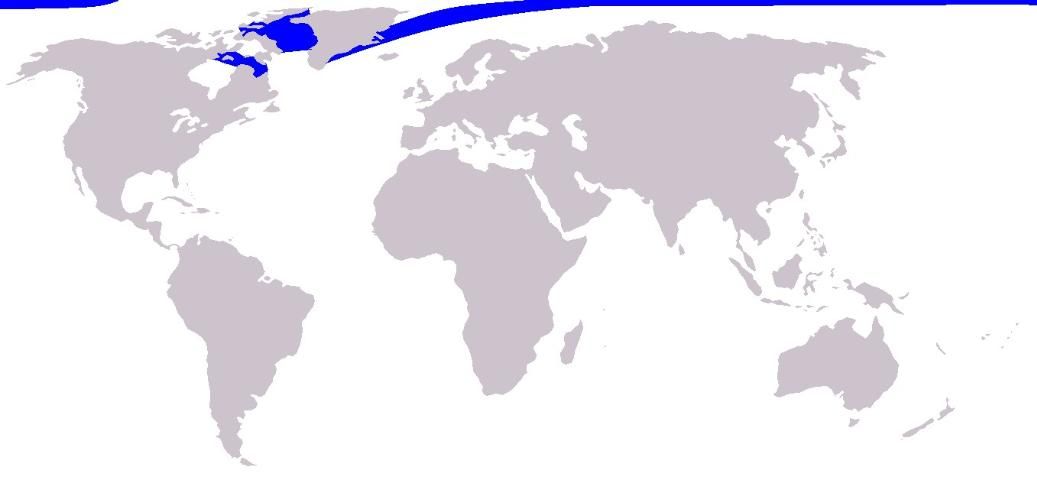
Credit: Pcb21/Wikimedia Commons
Pygmy Sperm Whale
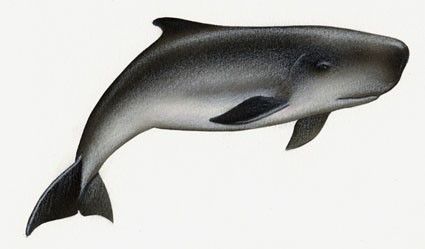
Credit: NOAA
Common Name: Pygmy sperm whale
Scientific Name: Kogia breviceps
Type of Whale: Toothed (odontocete)
Maximum Length: 11.5 feet (3.5 meters)
Maximum Weight: 1,000 pounds (450 kilograms)
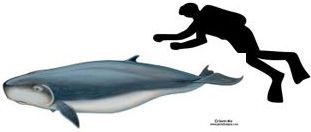
Credit: Garth Mix and Chris_huh
How long can they live? Not known
Where do they live? In temperate and tropical waters worldwide (Atlantic, Indian, and Pacific Oceans).
Special Characteristics: Pygmy sperm whales have a bracket-shaped marking resembling a fish's gill behind the eye. Pygmy sperm whales have no teeth in their upper jaws.
What type of prey do they eat? Squid, octopus, crabs, shrimp, and fish.
What type of predator might eat them? Unknown, but sharks will prey on stranding animals.
What are the human threats? On occasion, pygmy sperm whales are accidentally caught in commercial fishing nets and hit by ships. Some stranded pygmy sperm whales have had plastics and other garbage blocking their guts. Human noise may interfere with pygmy sperm whale behavior.
Are they endangered? No, but they commonly strand along the southeastern US coast.
Fun Facts: When pygmy sperm whales feel threatened, they can eject reddish-brown liquid (referred to as "ink") into the water to help them escape from predators. Pygmy sperm whales can probably dive to at least 1,000 feet (300 meters) in search of food.
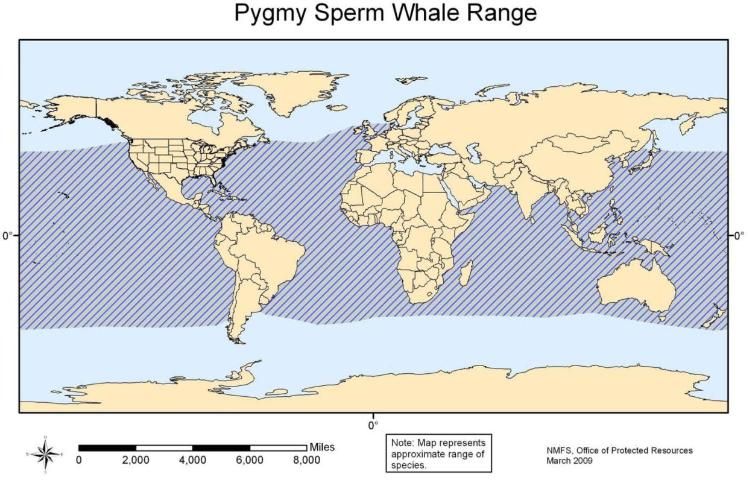
Credit: NOAA Fisheries Office of Protected Resources
Cuvier's Beaked Whale (Pronounced: COO-vee-yays)

Credit: Garth Mix
Common Name: Cuvier's beaked whale
Scientific Name: Ziphius cavirostris
Type of Whale: Toothed (odontocete)
Maximum Length: 23 feet (7 meters)
Maximum Weight: 6,800 pounds (3,100 kilograms)
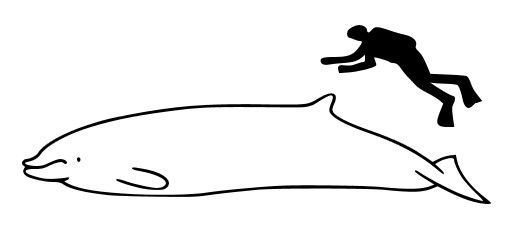
Credit: Chris_huh
How long can they live? Estimates are from 25 to 60 years.
Where do they live? Cuvier's beaked whales are found in most oceans and seas, except the polar regions.
Special Characteristics: The jawline is slightly upturned, giving the whale a "smiling" appearance. The lower jaw sticks out beyond the upper jaw. Males have two small, cone-shaped teeth that stick out of the lower jaw and are often used for fighting. Coloration ranges from dark gray to reddish-brown. The whales are often covered with scratches and scars.
What type of prey do they eat? Mostly squid and octopus, sometimes fish and crustaceans.
What type of predator might eat them? Unknown, but sharks will prey on stranding animals.
What are the human threats? Entanglement in fishing gear, ship strikes, and possible trauma from acoustic sources (noise). Cuvier's beaked whales are sometimes caught by Japanese whaling operations that are hunting other beaked whales.
Are they endangered? No. However, all cetaceans are protected under the Marine Mammal Protection Act.
Fun Facts: Cuvier's beaked whales use a pair of grooves in their throats to help them suck in their prey. They can dive down to 6,200 feet (1,888 meters) and hold their breath for up to 95 minutes. Cuvier's beaked whales are sometimes called "goosebeak" whales.
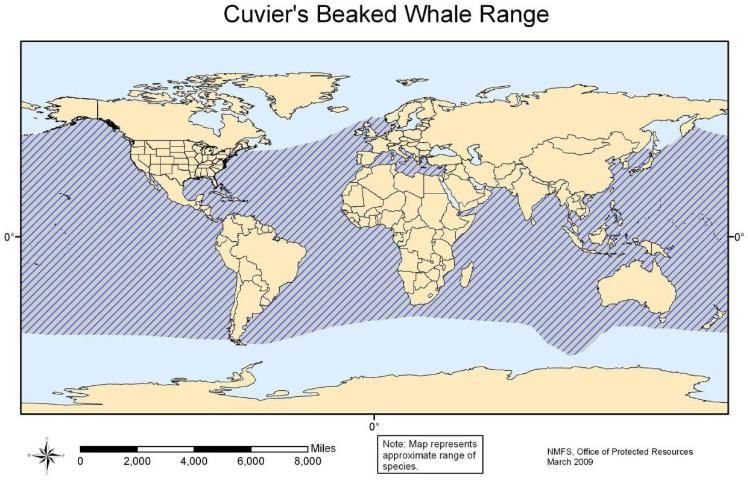
Credit: NOAA Fisheries Office of Protected Resources
Minke Whale (Pronounced: MIN-key)
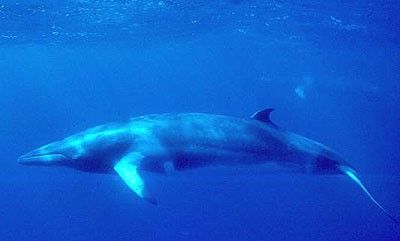
Credit: NOAA
Common Name: Minke whale
Type of Whale: Baleen (mysticete)
Maximum Length: 33 feet (10 meters)
Maximum Weight: 20,000 pounds (9,200 kilograms)
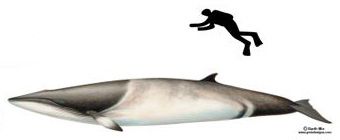
Credit: Garth Mix and Chris_huh
How long can they live? Scientists estimate minke whales can live up to 47 years.
Where do they live? Minkes are found in all oceans, although they are rarely observed in the tropics. They seem to prefer icy waters.
Special Characteristics: Minke whales vary in body size, patterns, coloration, and baleen based on geographic location.
What type of prey do they eat? Small schooling fish (capelin, cod, herring, pollock) or krill (small, shrimp-like plankton); sometimes copepods (plankton).
What type of predator might eat them? Orcas (killer whales)
What are the human threats? Minkes are sometimes hunted by whalers. Minkes may be accidentally trapped in commercial fishing gear. Underwater noise may interfere with the ability of minke whales to communicate.
Are they endangered? No. However, all cetaceans are protected under the Marine Mammal Protection Act.
Fun Facts: The minke whale is also known as the little piked whale. Minkes are fast swimmers and can reach speeds of 16 to 21 miles per hour (26 to 33 kilometers per hour). Minke whales can dive for up to 15 minutes. At sea, minke whales are curious and may approach vessels, especially stationary ones. Minke whales migrate seasonally.
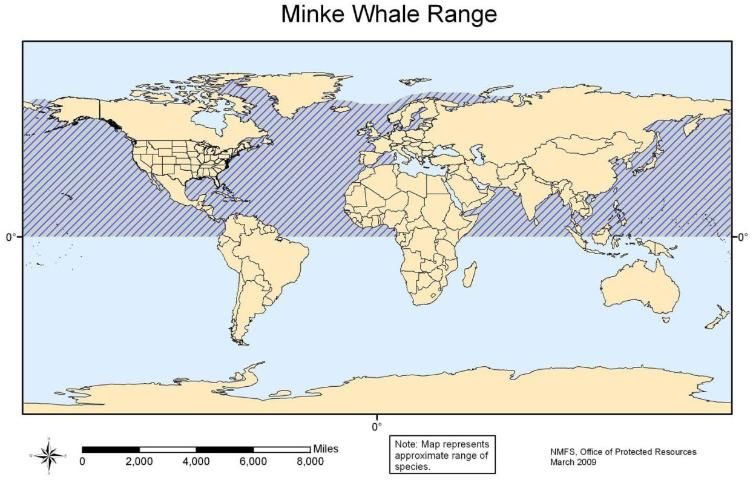
Credit: NOAA Fisheries Office of Protected Resources
Fin Whale
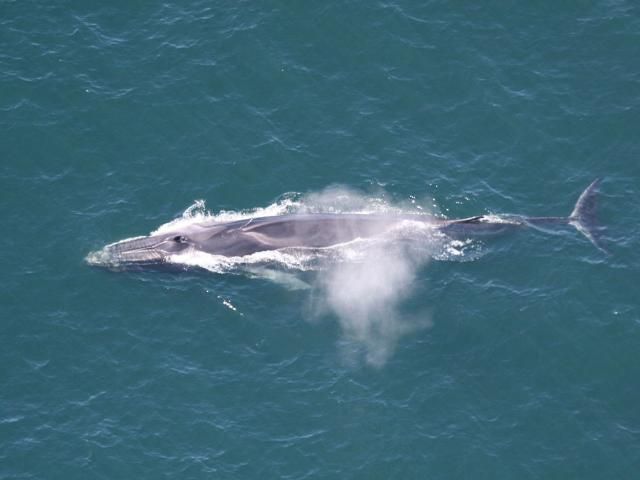
Credit: NOAA/NEFSC
Common Name: Fin whale
Scientific Name: Balaenoptera physalus
Type of Whale: Baleen (mysticete)
Maximum Length: 78 feet (24 meters) in the Northern Hemisphere; 88 feet (27 meters) in the Southern Hemisphere
Maximum Weight: 160,000 pounds (72,500 kilograms)

Credit: Garth Mix and Chris_huh
How long can they live? Scientists estimate they may live up to 100 years.
Where do they live? Fin whales are found in every ocean, but they seem to prefer temperate and polar waters.
Special Characteristics: The fin whale is light gray to brownish-black on its back and sides. These whales may have lighter-colored bands that start behind the blowholes, curve back towards the tail, then turn back towards the eye. The right side of the lower jaw is white or creamy yellow, while the left side is mottled black; this coloring is repeated on the baleen, but reversed on the tongue.
What type of prey do they eat? Small, shrimp-like animals called krill or euphausiids; schooling fish
What type of predator might eat them? Orcas (killer whales)
What are the human threats? From 1935 to 1965, whalers killed as many as 30,000 fin whales each year. The whales are now protected from hunting except for a small amount of tribal hunting in Greenland. Other threats include collisions with boats, entanglement in fishing gear, reduced prey supply due to overfishing, and disturbance from noise.
Are they endangered? Yes.
Fun Facts: Fin whales can eat up to 2 tons (4,400 pounds or 2,000 kilograms) of food a day. They can dive up to 1,800 feet (550 meters) and can hold their breath for up to 30 minutes. The age of fin whales can be estimated by counting the layers of waxy buildup in the ear canal.
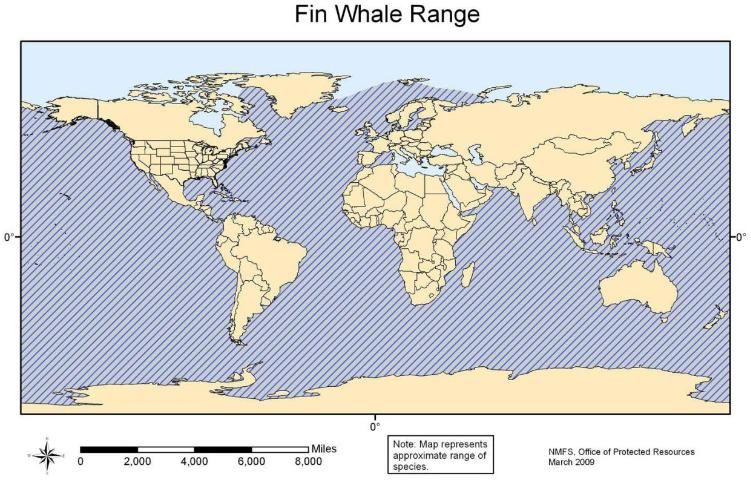
Credit: NOAA Fisheries Office of Protected Resources
Chinese River Dolphin
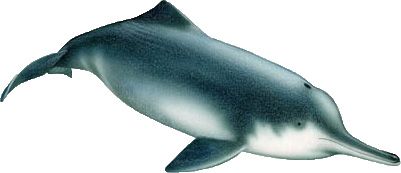
Credit: Alessio Marrucci
Common Name: Chinese river dolphin
Scientific Name: Lipotes vexillifer
Type of Whale: Toothed (odontocete)
Maximum Length: 8 feet (2.5 meters)
Maximum Weight: 500 pounds (220 kilograms)
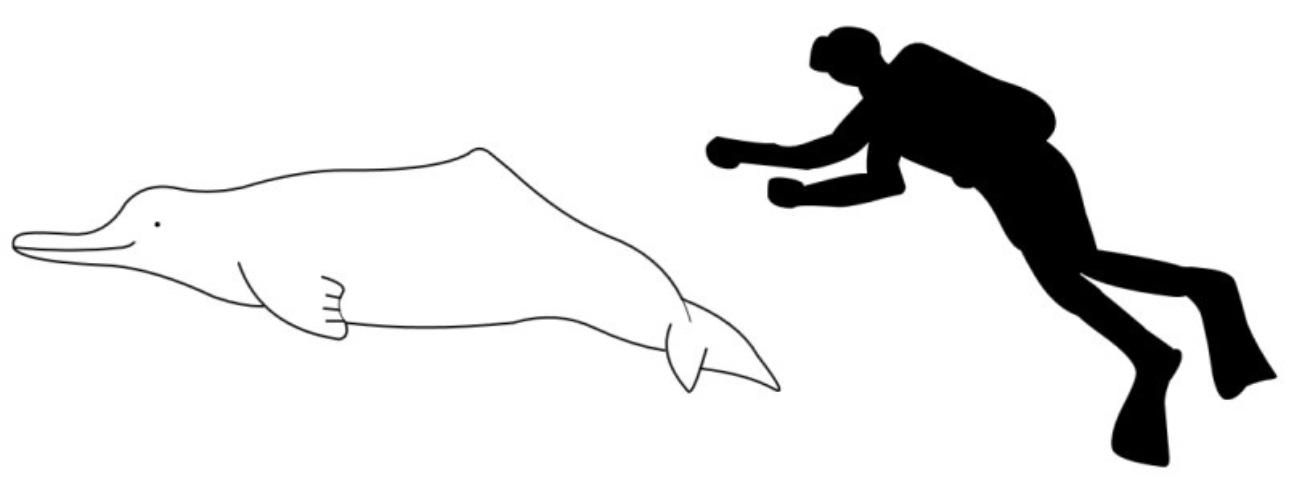
Credit: Chris_huh
How long can they live? Possibly up to 25 years (based on an individual in captivity).
Where do they live? Historically, these dolphins were found in the middle to lower reaches of the Yangtze (Yang-see) River. More recently, human development along the river has greatly reduced the habitat range.
Special Characteristics: The Chinese river dolphin is pale blue to gray on its back. It has very small eyes.
What type of prey do they eat? A variety of freshwater fish species.
What are the human threats? Chinese river dolphins are caught in fishing gear or killed by electrofishing (a technique that uses electricity to stun fish before they are caught). Other threats include pollution, river development projects, collisions with vessels, and loss of prey. Underwater explosions used to enlarge river channels have killed some dolphins.
Are they endangered? Yes. A survey conducted in 2006 failed to find a single Chinese river dolphin and concluded that this species may be extinct. The last sighting of a live Chinese river dolphin was in 2002.
Fun Facts: This dolphin was regarded as the goddess of protection by Chinese fishermen and boatmen in the Yangtze River region. It is also known as the Yangtze river dolphin, baiji, white-flag dolphin, and whitefin dolphin.
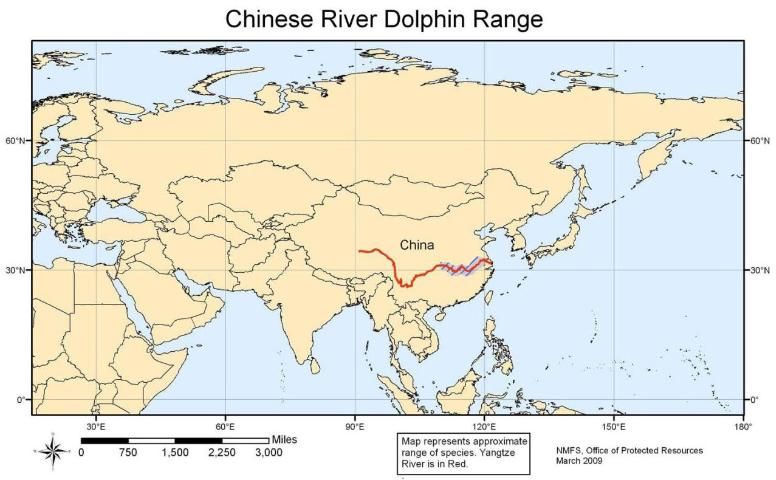
Credit: NOAA Fisheries Office of Protected Resources
Short-Finned Pilot Whale
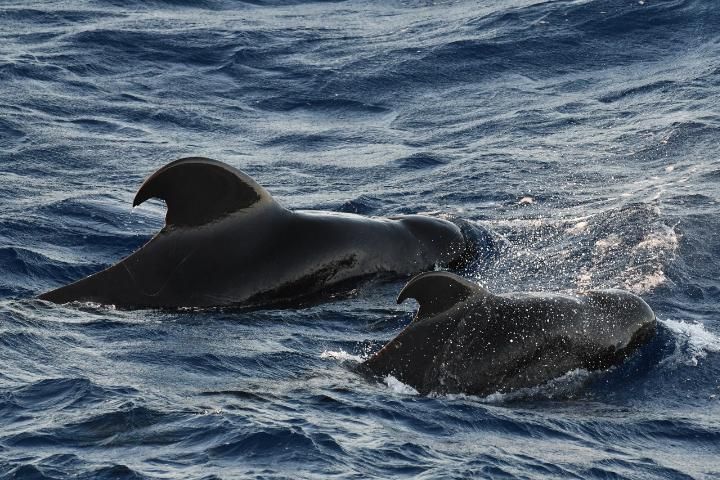
Credit: NOAA Fisheries/Adam Ü
Common Name: Short-finned pilot whale
Scientific Name: Globicephala macrorhynchus
Type of Whale: Toothed (odontocete)
Maximum Length: 24 feet (7.3 meters)
Maximum Weight: 6,600 pounds (3,000 kilograms)
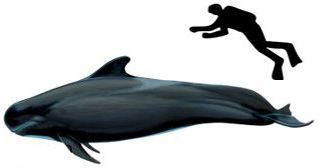
Credit: Garth Mix and Chris_huh
How long can they live? Up to 63 years
Where do they live? They are typically found in deeper waters throughout tropical and subtropical areas of the world.
Special Characteristics: Short-finned pilot whales have a bulbous melon head with no noticeable beak. These whales are black or dark brown with a large gray "saddle" behind the dorsal fin.
What type of prey do they eat? Mostly squid, some octopus, and fish in deep water (1,000 feet/300 meters or more).
What type of predator might eat them? Unknown, but sharks will prey on stranding animals. Pilot whales are often involved in mass strandings (up to several hundred whales at a time).
What are the human threats? Pilot whales get entangled, hooked, and captured by different kinds of commercial fishing gear. There are pilot whale fisheries in Japan and the Lesser Antilles. Ships can hit pilot whales.
Are they endangered? No. However, all cetaceans are protected by the Marine Mammal Protection Act. These whales are involved in "mass stranding" events along the Florida coastline every few years. Some of these stranding events may involve more than 100 animals coming onshore at the same time.
Fun Facts: Short-finned pilot whales are the second largest species in the dolphin family (after the orcas or killer whales). Pilot whales are very social animals and are most often found in groups of 20 to 90 whales. Pilot whales are exhibited in many aquariums and zoos.
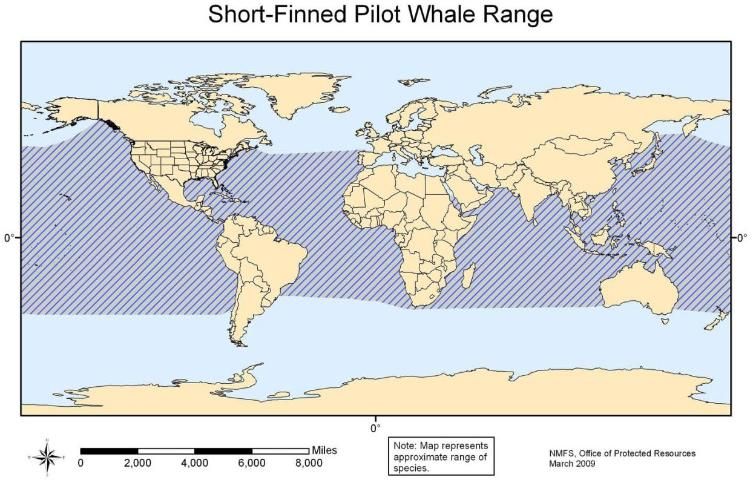
Credit: NOAA Fisheries Office of Protected Resources
Spinner Dolphin
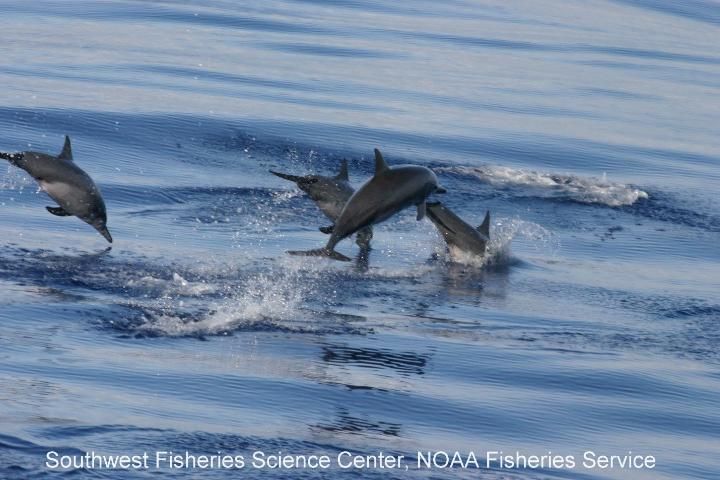
Credit: NOAA/Southwest Fisheries Science Center
Common Name: Spinner dolphin
Type of Whale: Toothed (odontocete)
Maximum Length: 7 feet (2 meters)
Maximum Weight: 170 pounds (77 kilograms)
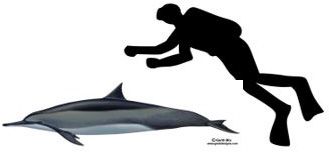
Credit: Garth Mix and Chris_huh
How long can they live? Unknown
Where do they live? Spinner dolphins are found in all tropical and subtropical oceans.
Special Characteristics: Spinner dolphins have long, slender snouts or beaks. They are known for leaping out of the water and spinning (up to four revolutions) as many as 14 times in a row.
What type of prey do they eat? Midwater fishes and deepwater squid.
What type of predator might eat them? Sharks, orcas (killer whales), and possibly false killer whales, pygmy killer whales, and pilot whales.
What are the human threats? Spinner dolphins are often trapped and drowned in yellowfin tuna nets.
Are they endangered? No. However, the eastern Pacific population of spinner dolphins is considered depleted due to impacts from tuna fishing. All cetaceans are protected by the Marine Mammal Protection Act.
Fun Facts: Spinner dolphins are often seen in groups of several hundred to several thousand animals. They feed mostly at night and rest during daylight hours.
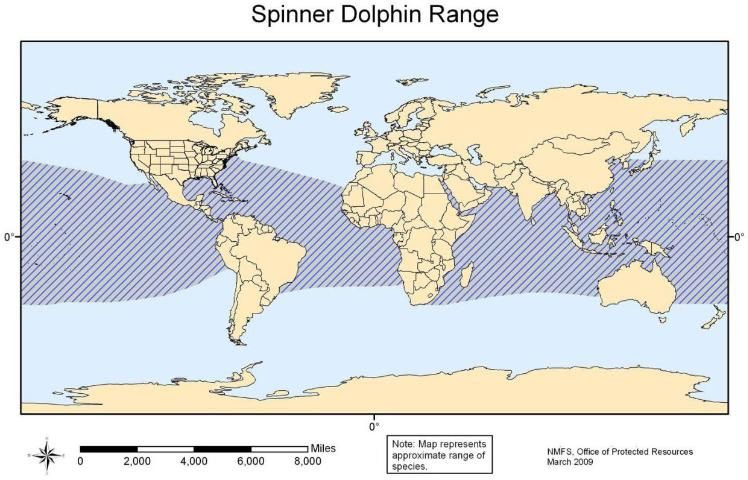
Credit: NOAA Fisheries Office of Protected Resources
Gray Whale
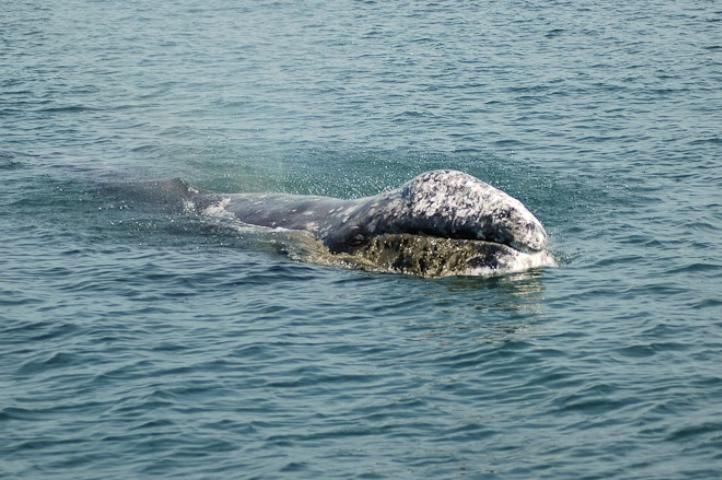
Credit: Merrill Gosho, NOAA
Common Name: Gray whale
Scientific Name: Eschrichtius robustus
Type of whale: Baleen (mysticete)
Maximum Length: 50 feet (15 meters)
Maximum Weight: 80,000 pounds (35,000 kilograms)

Credit: Chris_huh
How long can they live? Up to 80 years
Where do they live? Gray whales live in shallow coastal waters of the North Pacific Ocean.
Special Characteristics: Gray whales have a mottled gray body, with small eyes located just above the corner of the mouth. They do not have a dorsal fin, but they have a "dorsal hump" about two-thirds of the way back on the body, as well as a series of small bumps known as "knuckles" between the dorsal hump and the tail. Gray whales commonly have white barnacles and orange crab-like animals called cyamids on their bodies.
What type of prey do they eat? Small, shrimp-like amphipods that live in mud on the seafloor.
What type of predator might eat them? Orcas (killer whales).
What are the human threats? Before the mid-1930s, gray whales were hunted commercially. Modern-day threats include collisions with boats, entanglement in fishing gear, disturbance from ecotourism and whale watching, and disturbance from noise.
Are they endangered? Only the western Pacific population of gray whales is listed as endangered.
Fun Facts: A gray whale's tail flukes are more than 15 feet (3 meters) wide. Whalers once called gray whales "devil fish." Gray whales make one of the longest annual migrations of any mammal—they travel about 10,000 miles (16,000 kilometers) round trip. Gray whales are frequently visible from shore. Some will approach small boats and allow humans to touch them. A gray whale can hold its breath for about 25 minutes and can dive to depths of about 550 feet (170 meters).
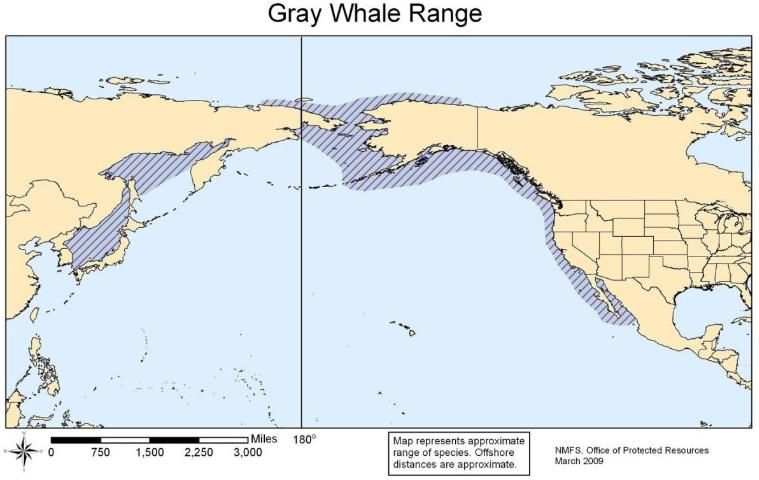
Credit: NOAA Fisheries Office of Protected Resources